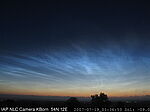IAP NLC cameras
Camera network for automated observation of Noctilucent clouds (NLC)
The spatial expansion as well as the horizontal structure of noctilucent clouds (NLC) on continental as well as small scales is observed by the combination of the cameras in Europe. In particular the southern extent of the NLC is examined to clear the question whether and how often the NLC penetrate to low latitudes.
This network is in particular motivated by the newest model results which have unexpectedly predicted the expansion till low latitudes (approx. 40°N). In addition, the camera observations should be combined with the observations by Lidar instruments in Kühlungsborn and at ALOMAR to follow of the question of the source of short period variations in NLC.
The NLC cameras are found here.
Method
The IAP has developed an automated camera system consisting of a high-resolution digital camera (7 Megapixel) and a computer to the control of the camera. For the automated observation of the sky in the twilight period a control software was developed which allows to cover the huge dynamic range of the sky lights. The pictures are sent via Internet to the IAP on a near real-time basis and are put into archives. During the NLC season the data volume is about 3.5 GByte/day.
Results
The unexpected predictions of the LIMA/ICE model that NLC can also appear in low latitudes were confirmed. For the first time we observed a NLC in the morning hours on June 29, 2006 with our camera in the Pyrenees. We could observe more NLC on June 22, 2006 and in summer, 2007. This shows unambiguously that the model result are right in this regard. In combination with the Lidar and radar measurements on ALOMAR the observation of a NLC with our camera in Trondheim was used to make the the launch decision of two sounding rockets during the ECOMA/MASS campaign.
Selected publications
- M. Gerding, G. Baumgarten, M. Zecha, F.-J. Lübken, K. Baumgarten und R. Latteck, On the unusually bright and frequent noctilucent clouds in summer 2019 above Northern Germany, J. Atmos. Solar-Terr. Phys., 217, doi:10.1016/j.jastp.2021.105577, 2021.
- G. Baumgarten and D. C. Fritts, Quantifying Kelvin-Helmholtz instability dynamics observed in Noctilucent Clouds: 1. methods and observations, J. Geophys. Res., 9324–9337, doi:10.1002/2014JD021832, 2014.














